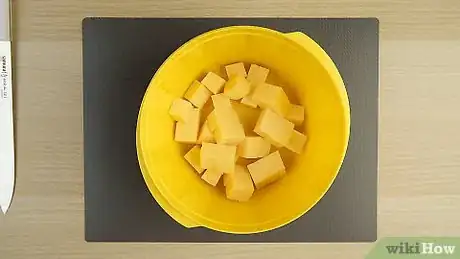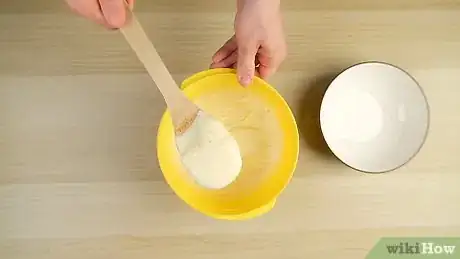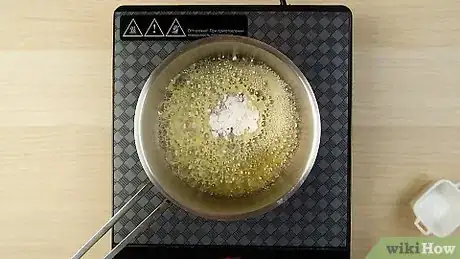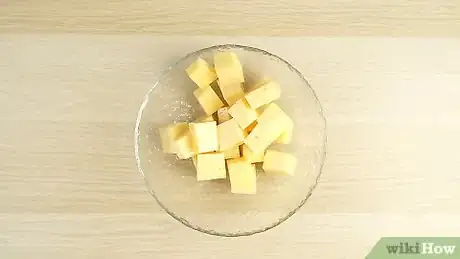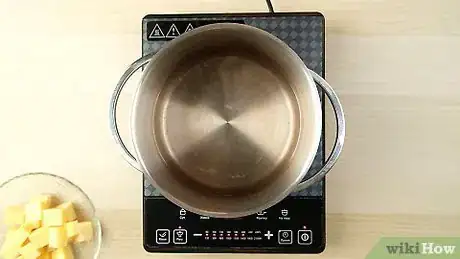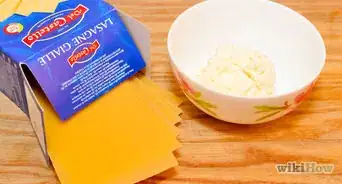This article was co-authored by wikiHow Staff. Our trained team of editors and researchers validate articles for accuracy and comprehensiveness. wikiHow's Content Management Team carefully monitors the work from our editorial staff to ensure that each article is backed by trusted research and meets our high quality standards.
The wikiHow Video Team also followed the article's instructions and verified that they work.
This article has been viewed 106,541 times.
Learn more...
Melted cheese is a great addition to nearly any savory dish. If all you have is block cheese, though, you may not know just how to turn it into gooey, delicious melted cheese. Fortunately, whether you’re using a microwave, saucepan, or steamer basket, there are a number of ways to easily melt block cheese.
Ingredients
- Cheese
- Cornstarch
- Flour (optional)
- Evaporated milk
- 2% or whole milk
Steps
Using a Microwave
-
1Place the cheese in a microwave-safe bowl. Any plastic or glass bowl labeled “microwave safe” or “heat-resistant” will work. If you want to add any special ingredients to your cheese, place them in the bowl as well.[1]
- For example, if you want to make a nacho cheese dipping sauce, add a dash of chili powder to the cheese when you put it in the bowl.
- For best results, shred the cheese with a grater or chop the cheese into 1 in (2.5 cm) cubes before you put it in the bowl. This will speed up the melting process.
-
2Add cornstarch and evaporated milk to the bowl to get a smoother melt. For every 1 cup (125 grams) of cheese you place in the bowl, add 1 tablespoon (15 grams) of cornstarch and 1 cup (240 mL) of evaporated milk to the bowl as well. This will make your melted cheese silky and smooth instead of stringy.[2]
Tip: If you don’t have evaporated milk, you can also use ordinary milk. However, this may end up making your melted cheese a lot smoother and less gooey than evaporated milk does.
Advertisement -
3Put the bowl in the microwave and heat it for 30 seconds, then stir. For best results, use high heat when you’re microwaving the bowl. After about 30 seconds, use a spoon or fork to stir all the contents of the bowl together as needed to get a creamy cheese sauce.[3]
- Be very careful when touching the sides of the bowl, since it may be very hot when you go to take it out of the microwave.
-
4Microwave the bowl for another 30 seconds, if necessary. Depending on how many ingredients you placed in the bowl, the cheese may not be completely melted. If this is the case, simply heat it up again for 20-30 seconds or until it has visibly melted to your taste. Once it’s completely melted, remove the bowl from the microwave and serve the cheese.[4]
- It may take several minutes for your cheese to melt completely, so don’t get frustrated if it doesn’t melt after 1 or 2 tries.
- Cheese melted in the microwave works great as a cheese sauce you can use for dipping, or for pouring over your favorite snacks!
Melting Cheese in a Saucepan
-
1Shred or chop your cheese to make it easier to melt. Use a grater to shred the cheese into narrow strips or a knife to chop it into 1 in (2.5 cm) cubes. The smaller the surface area of your cheese is, the quicker it will melt.[5]
- Place your cheese into a bowl and set it aside for now.
-
2Melt some butter in a saucepan over medium heat. Place the saucepan over medium heat, which is equal to the middle number on your stovetop dial. Then, place about 2 tablespoons (30 grams) of sliced butter in the pan and allow it to melt.[6]
- For example, if your stovetop dial goes from 1 to 10, then medium heat will be around 5 or 6.
-
3Whisk flour or cornstarch into the butter and cook it for 1 minute. You can add either 2 tablespoons (16 grams) of all-purpose flour or 2 teaspoons (5 grams) of cornstarch to the pan, whichever you prefer. As you cook the flour or cornstarch, use a whisk to continuously stir it into the butter so that it mixes into it.[7]
- If you want to make a thicker cheese sauce (e.g., for dipping), add 3 tablespoons (24 grams) of flour or 3 teaspoons (7.5 grams) of cornstarch to the pan.
- Keep the saucepan over medium heat throughout this process.
-
4Add milk to the saucepan very slowly while whisking your ingredients. Pour 2 cups (470 mL) of milk into the butter and flour mixture while continuously whisking the ingredients to make sure they completely mix. For best results, use 2% or whole milk instead of nonfat milk.[8]
- If you want to add any other ingredients, such as salt and pepper to taste, add them at this stage as well.
Warning: Be sure to pour the milk very slowly into the saucepan; if you pour it too quickly, you may cause some of the hot butter to splash out of the pan.
-
5Remove the saucepan from heat and add the cheese. Place the pan on an unused eye on your stove or on another heat-safe surface. Carefully place the cheese in the pan and stir it into the rest of the ingredients.[9]
-
6Stir the cheese until it’s completely melted and smooth. It should only take about 3-5 minutes for the cheese to completely melt. Serve the cheese immediately after it’s melted to get the best flavor out of it.[10]
- This kind of melted cheese can work well as a pasta sauce, or as the topping for some delicious macaroni and cheese.
Steaming the Cheese
-
1Place the cheese in a sturdy heat-resistant bowl. Use a glass or a ceramic bowl labeled “heat-resistant.” For best results, use a grater to shred the cheese or use a knife to chop it into 1 in (2.5 cm) cubes before placing it in the bowl.[11]
- The bowl will need to be sturdy and heat-resistant since it will be placed directly over scalding hot steam.
-
2Bring some water to a boil in a large pot. Fill a pot about halfway with water and place it on the stovetop over high heat. High heat is the highest heat setting on your stovetop dial. Leave the pot on the eye until the water begins to boil.[12]
- For example, if your stovetop dial goes from 1 to 8, then high heat is the 8 setting.
- Be sure to use a pot with a small enough circumference that a steamer basket can fit over top of it.
-
3Lay a steamer basket over the top of the pot. Make sure the basket stays in place when it’s on top of the pot and doesn’t fall off or into the water. Use a basket with a handle on the side so you can safely remove the basket later.[13]
- For even extra safety, use a steamer basket with a handle made of a heat-resistant material like rubber that won’t pose any risk of burning your hand.
-
4Put the bowl of cheese in the steamer basket to melt the cheese. It should take about 5 minutes for the cheese to melt, but keep your eye on it in case it melts in less time. Stir the cheese as necessary in order to break up any large chunks that form in the bowl.[14]
- Don’t put the cheese directly into the steamer basket. The melted cheese will simply pour through the holes in the basket and down into your boiling water.
-
5Remove the bowl once the cheese has melted and turn off the stove. Use heat-resistant oven mitts to take the bowl out of the steamer basket and set it to the side. Serve the cheese right away.[15]
- Cheese melted with a steamer is best paired with croutons, or with cubed meat as a creamy fondue sauce.
Things You’ll Need
Using a Microwave
- Microwave
- Microwave-safe bowl
- Knife or grater
- Spoon or fork
Melting Cheese in a Saucepan
- Knife or grater
- Saucepan
- Whisk
Steaming the Cheese
- Knife or grater
- Heat-resistant bowl
- Pot
- Steamer basket
- Oven mitts
References
- ↑ https://spoonuniversity.com/how-to/how-to-make-nacho-cheese-sauce-in-the-microwave
- ↑ https://www.seriouseats.com/2015/10/the-food-lab-fifteen-minute-stovetop-macaroni-and-cheese-recipe-food-lab-book-excerpt.html
- ↑ https://www.youtube.com/watch?v=9uQyqK-A8p4#t=30s
- ↑ https://spoonuniversity.com/how-to/how-to-make-nacho-cheese-sauce-in-the-microwave
- ↑ https://fountainavenuekitchen.com/easy-cheese-sauce/
- ↑ https://fountainavenuekitchen.com/easy-cheese-sauce/
- ↑ https://fountainavenuekitchen.com/easy-cheese-sauce/
- ↑ https://www.rachelcooks.com/2018/05/14/easy-cheese-sauce/
- ↑ https://fountainavenuekitchen.com/easy-cheese-sauce/
- ↑ https://fountainavenuekitchen.com/easy-cheese-sauce/
- ↑ https://aht.seriouseats.com/2011/07/the-burger-lab-how-to-make-any-cheese-melt-like-american-almost.html
- ↑ https://aht.seriouseats.com/2011/07/the-burger-lab-how-to-make-any-cheese-melt-like-american-almost.html
- ↑ https://aht.seriouseats.com/2011/07/the-burger-lab-how-to-make-any-cheese-melt-like-american-almost.html
- ↑ https://aht.seriouseats.com/2011/07/the-burger-lab-how-to-make-any-cheese-melt-like-american-almost.html
- ↑ https://aht.seriouseats.com/2011/07/the-burger-lab-how-to-make-any-cheese-melt-like-american-almost.html
